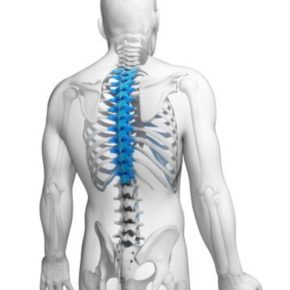For centuries, fellow humans have canvassed the globe in a desperate yet futile search for eternal life, longevity, or — at the very least — the magical, secret potion that will somehow slow down the aging process.
 What if the secret has been right there with us the whole time?
What if the secret has been right there with us the whole time?
Most spinal experts agree that spinal motion is essential to overall body health. Your yoga teacher has likely imparted similar advice while asking you to perform difficult back bends. A good personal trainer will incorporate spinal mobility drills either as part of your dynamic warm-up or throughout your training program. Joseph Pilates has been quoted as suggesting, “If your spine is inflexibly stiff at 30, you are old. If it is completely flexible at 60, you are young.”
I’m going to get even more specific here and narrow our focus down to the T-spine, or thoracic spine. Our T-spine is comprised of 12 vertebrae (T1 – T12), known more commonly as the upper- and middle- back. Its predominant roles are stability, posture, and the protection of our vital organs. When these vertebrae are moving the way they’re supposed to, our body is most efficient: better circulation, healthy immune system, upright posture and infinite potential for the rest of the body to be strong, agile, and whole.
When we lose that fluid mobility, whether it be from years of inactivity, countless hours sitting at a desk, or even a life on the road, our entire Qi is disrupted, leading to a host of trouble: pain, injury, and an increased risk for compensatory patterns by supporting muscle groups and/or vertebrae.
Think about it: look around the office. How many of your cohorts are sitting a la Quasimodo, hunched over their keyboards? Shuffling across the room with their eyes fixated on the ground? Now, how many of those people are overweight? You can see where I’m going here.
Conversely, recall the last time you saw someone who just seemed to… have it: confidence, poise, grace. Posture is the first step in creating that in ourselves.
My best news here is that it’s never too late to make improvements to your spinal mobility.
Try yoga. Most practices will include variations on spinal extensions, twists, and stretches that will help. If yoga is not your thing, get into the weight room and incorporate exercises that work on the muscles that support the spine: rows, cable pulls, and traditional core exercises can make a big difference. Pilates is also a wonderful, super-efficient modality to increase both strength and mobility in our core. It’s great to find something you love; however it’s better that you actually do it regularly.
Here is a sample of simple exercises you can do on your own. If you don’t feel like you’re performing these correctly, ask a professional to help you.
 Jodilyn Stuart is the Health & Sports Senior Staff Writer for 303 Magazine, owner of ModaBody Fitness, and has been a professional fitness geek since 1997. If you have questions, feel free to email at: Jodilyn@303Magazine.com
Jodilyn Stuart is the Health & Sports Senior Staff Writer for 303 Magazine, owner of ModaBody Fitness, and has been a professional fitness geek since 1997. If you have questions, feel free to email at: Jodilyn@303Magazine.com





